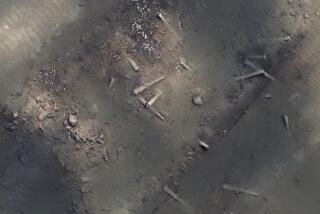Treasure Hunter Resumes a Dream to Dive For
- Share via
MORTON, Ill. — The last time that Scott Heimdal set out in search of sunken treasure, he ended up being the bounty instead, kidnapped and held for ransom in the jungles of South America for two months not knowing whether he would live or die.
Now, nearly 15 years after his central Illinois hometown raised the cash that bought his freedom, Heimdal is preparing to head back to Ecuador to resume a treasure-hunting dream that still burns hotter than his memories of 61 days at the mercy of Colombian rebels.
The 42-year-old former hostage says this trip will be much safer.
Instead of guerrillas, he says, his biggest worry will be finding a Spanish galleon that sank off the coast of Ecuador in the late 1500s with a cargo he estimates could be worth hundreds of millions of dollars.
“I’ve always been someone who likes to see things through. If you decide to do something, do it,” the soft-spoken Peoria native said with a laugh.
Even his parents, who went to South America and negotiated their son’s release in 1990, say they have no qualms about Heimdal rekindling a dream sparked by a documentary on shipwreck recoveries he saw as a teenager.
“What happened to him when he got kidnapped was just that he was in the wrong place at the wrong time,” said his father, Roy Heimdal.
At the time, though, he feared that the rebels would kill or never release his son. “It was awful; I almost lost my mind,” he recalled.
Heimdal wound up within the rebels’ reach after signing on with a mining company to support himself when the Ecuadorean government thwarted his bid for a permit to salvage a potential shipwreck that he had spent years researching.
He was working on a goldmine being established deep in the jungle when rebels crossed over from Colombia and ambushed Heimdal’s canoe from a riverbank. They killed his native navigator, a 16-year-old youth, and abducted Heimdal, seeking ransom money to finance their efforts to overthrow Colombia’s government.
Heimdal’s captivity made international news as rebels demanded $1.5 million for his release, unaware that the goldmine was not yet operating. They ultimately settled for $60,000, a deal negotiated by Heimdal’s mother, Marge, using money from fundraisers throughout central Illinois.
More than 50 members of the insurgent group have since been arrested, although none has gone to trial.
Other rebel groups are still carrying on the decades-old insurgency, but Heimdal said he would be out of harm’s way on this trip.
He will be working with the Ecuadorean Navy on the salvage project, operating under a deal based on a new Ecuadorean law to evenly split any coins, jewelry or artifacts that might be found on the ocean floor.
When Heimdal and his crew aren’t with government officials, they will stay in a resort-like area along the Pacific Ocean.
“It’s like anywhere; it really depends on where you are. If you’re out in the middle of the jungle and you’re close to the Colombian border, you need to be careful. The rest of the country, it’s a wonderful country,” he said.
Heimdal, who works for a computer consulting firm, prefers not to dwell on his weeks as a hostage.
But he acknowledges that his past could help as the new company he formed, RS Operations LLC, tries to attract investors for the nearly $500,000 salvage effort in Ecuador. The Peoria-based company has about one-fourth of the money it needs, and Heimdal hopes to collect the rest and launch the yearlong project by early next year.
The ship that caught his eye is the Clarius, which sank in 1594 in the early era of galleons, the ships that carried the riches that conquistadors took from the Incas they conquered and the mines those people left along 1,000 miles of South America’s west coast. Coins and other artifacts that have washed ashore are signs that more may lie beyond, Heimdal said. “I have no doubt. The question is how much,” he said.
Shipwreck salvage is a growing industry worldwide, said Laura Barton of Odyssey Marine Exploration Inc., a Tampa, Fla.-based company that specializes in deep-sea exploration and recovery projects.
High-profile projects like the 1985 discovery of the Titanic heightened interest in underwater treasure hunts, and technological advances like underwater robots have helped searchers reach deeper parts of the ocean, she said.
“As these projects get more press and publicity, more and more people are going to say, ‘Wow, there’s money down there,’ ” Barton said.
But salvage is also a risky business, Heimdal said. Projects could turn up nothing or have staggering returns.
A Civil War-era shipwreck discovered by Odyssey Marine off the Georgia coast last year has already yielded more than 50,000 gold and silver coins and is estimated to be worth more than $120 million.
More to Read
Sign up for Essential California
The most important California stories and recommendations in your inbox every morning.
You may occasionally receive promotional content from the Los Angeles Times.










